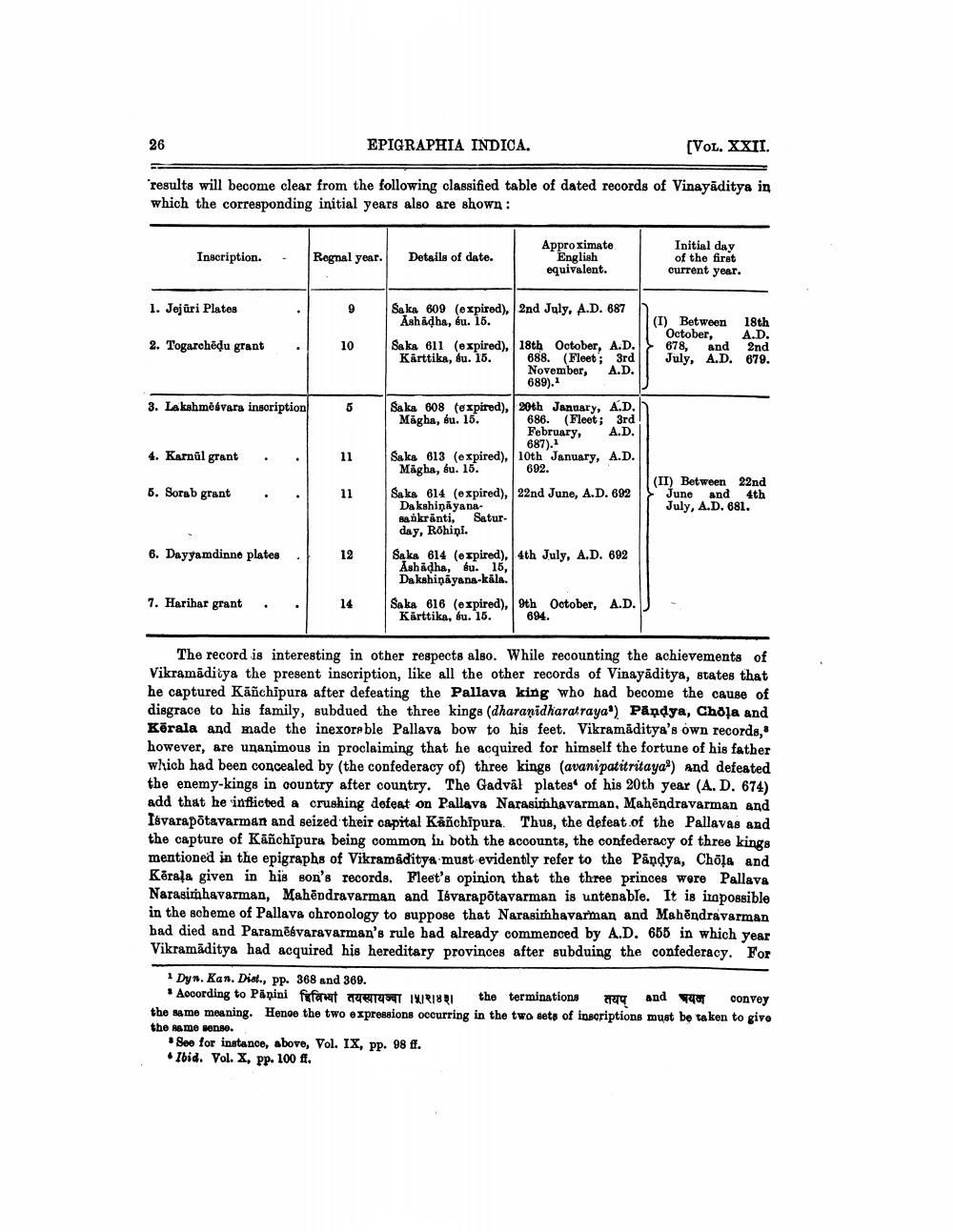________________
26
EPIGRAPHIA INDICA.
[VOL. XXII.
"results will become clear from the following classified table of dated records of Vinayāditya in which the corresponding initial years also are shown:
Inscription.
.
Rognal year.
Details of date.
Approximate
English equivalent.
Initial day of the first current year.
1. Jejūri Plates
2. Togarchēdu grant
Saka 609 (expired), 2nd July, A.D. 687 h
Ashādha, bu. 15. Saka 611 (expired), 18th October, A.D. Kärttika, du. 15. 688. (Fleet; 3rd
November, A.D. 689).
(I) Between
October, 678, and July, A.D.
18th A.D. 2nd 679.
3. La kahmēsvara inscription
4. Karnül grant
.
.
6. Sorab grant
.
.
Saka 608 expired), 20th January, A.D. Mágha, bu. 15. 686. (Fleet; 3rd
February,
A.D.
687). Saks 613 (expired), 10th January, A.D. Mágha, éu. 15.
|| (II) Between 22nd Saka 614 (expired), 22nd June, A.D. 692 June and 4th Dakshinayana
July, A.D. 681. sankranti, Saturday, Röhini. Saka 614 (expired), 4th July, A.D. 692 Ashādha, bu. 15, Dakshiņāyana-kāla. Saka 616 (expired), 9th October, A.D.) Kärttika, bu. 15. 694.
6. Dayyamdinne plates
7. Harihar grant
.
.
The record is interesting in other respects also. While recounting the achievements of Vikramāditya the present inscription, like all the other records of Vinayāditya, states that he captured Kanchipura after defeating the Pallava king who had become the cause of disgrace to his family, subdued the three kings (dharanidharatraya) Pandya, Chola and Kērala and made the inexorable Pallava bow to his feet. Vikramăditya's own records, however, are unanimous in proclaiming that he acquired for himself the fortune of his father which had been concealed by (the confederacy of) three kings (avanipatitritaya) and defeated the enemy-kings in country after country. The Gadväl plates of his 20th year (A.D. 674) add that he 'inflicted a crushing defeat on Pallava Narasimhavarman, Mahēndravarman and Isvarapötavarman and seized their capital Kāñchipura. Thus, the defeat.of the Pallavas and the capture of Kāñchipura being common in both the accounts, the confederacy of three kings mentioned in the epigraphs of Vikramaditya must evidently refer to the Pandya, Chola and Kērala given in his son's records. Fleet's opinion that the three princes were Pallava Narasimhavarman, Mahēpdravarman and Isvarapotavarman is untenable. It is ira possible in the scheme of Pallava chronology to suppose that Narasimhavarman and Mahēndravarman had died and Paramēbvaravarman's rule had already commenced by A.D. 658 in which year Vikramaditya had acquired his hereditary provinces after subduing the confederacy. For
1 Dyn. Kan. Dist., pp. 368 and 369.
*According to Panini हिविभ्यां तयस्थायज्वा ॥राश the terminations तयप and अयण convey the same meaning. Hence the two expressions occurring in the two sets of inscriptions must be taken to give the same sense. . See for instance, above, Vol. IX, pp. 98 ff. Ibid. Vol. X, pp. 100 ff.




